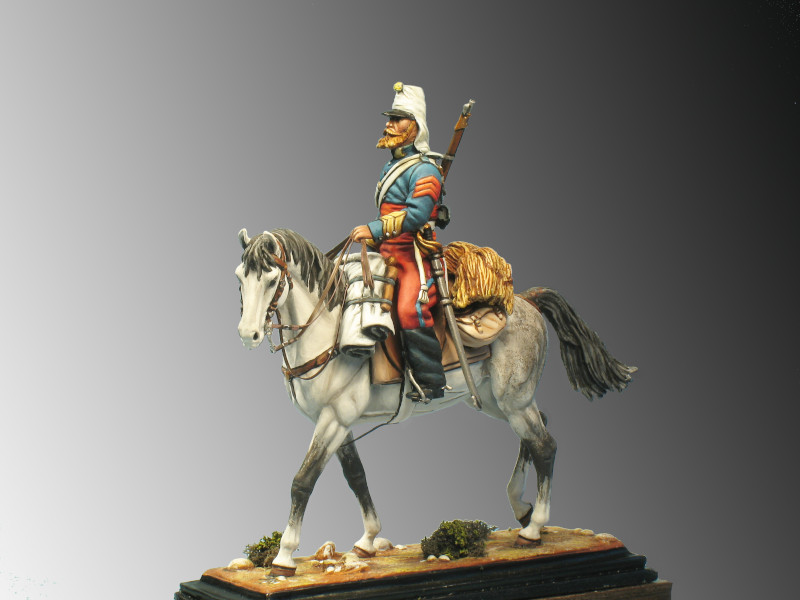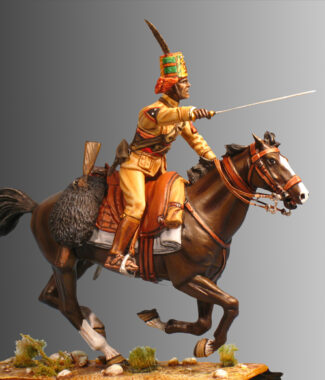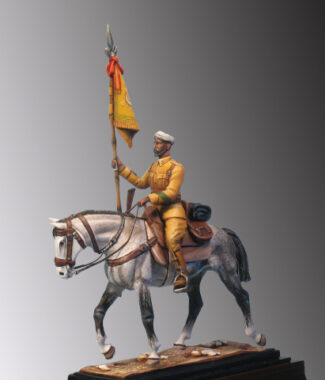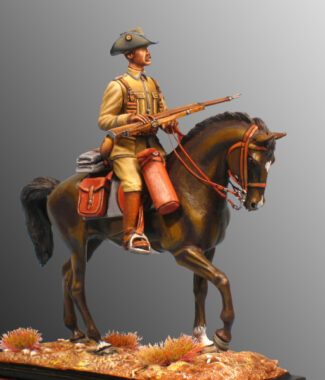You must be logged in to post a review.
1st Regiment of Chasseurs d’Afrique – 1863
€65.00
Figure to assemble and paint
Ref.: 8 – TC
Weight: 260 grs.
Material: White Metal
Number of Pieces: 15
Historical Review:
When they landed at Sidi-Ferruch in June 1830 and during the first months of exploring the immense territory that lay before them, the French command made the mistake of believing that the army would have to act as a group and, no doubt, conduct a siege. It did not imagine that it would have to pursue an extremely mobile and fluid enemy with small, fast, light and frustrated independent units. This explains the paucity of cavalry in the expeditionary corps, which consisted of just three squadrons of Chasseurs à Cheval.
It is not surprising that the first need for local reinforcements was for mounted units. At the beginning of 1831, two squadrons of “Algerian Chasseurs” were created, recruited from among the natives and attached to the Zouaves corps, itself set up in August 1830. Two regiments of “Chasseurs d’Afrique” were formed from these native squadrons by royal decree on 17 November 1831.
In 1839, it was deemed necessary to add French contingents to these poorly disciplined Arab-Berber cavalrymen. However, the command noted that “the customs, habits, religion, clothing and way of life of the natives prevented the Arab cavalrymen from being assigned to the French squadrons of the Régiment de Chasseurs d’Afrique”. In December 1841, the indigenous squadrons of the four Chasseurs d’Afrique regiments were transferred to the newly created Spahis corps, which was much better adapted to the way the natives fought. The Chasseurs d’Afrique thus became completely French.
Their experience of the war in Algeria quickly promoted the Chasseurs d’Afrique to the very top of the French cavalry. There was hardly a campaign in which the Chasseurs d’Afrique were not involved. The cross of the Legion of Honour was awarded to the standard of the 1st R. C. A. (Régiment de Chasseurs d’Afrique) in 1863 as a reward for the capture of a Mexican Lancers’ standard in the battle of San Pablo Del Monte, near Puebla, during the Mexican Campaign.
The Chasseurs d’Afrique once again came to prominence during the Franco-Prussian War of 1870-1871. The magnificent charge of the Division Marguerite on 1 September 1870 at Floing produced no tactical results, but prompted the King of Prussia to utter the famous words “Ah, les braves gens! Three regiments of Chasseurs Afrique had charged full tilt several times, ready to do it again “as long as there is one left”, for the sake of honour, and their losses were very heavy.
The most brilliant officers sought the honour of serving in the Chasseurs d’Afrique as a favour. Non-commissioned officers gave up a stripe to join. Promotion was blocked by the influx of volunteers. Not only do they form a magnificent collection of original types, but they are the living tradition of practical warfare. Their only ambition is to fight.
Their hairstyles have always been distinctive. At the end of the 19th century, they wore the “taconnet”, a cavalry cap modelled on the 1873 model, often covered with white calico. At the end of the 19th century, the Chasseurs d’Afrique adopted the madder-coloured fez, worn high and straight, with three parallel black stripes at the base. These three black stripes are a reminder of the mourning for the three Chasseurs d’Afrique regiments that charged at Floing in 1870.
In addition to the colonial expeditions in which they took part in the nineteenth and twentieth centuries, they were present during the two great world conflicts of 1914-1918 and 1939-1940, not only on French soil, but also in the Balkans and the Orient from 1916 to 1919 and in the Levant until 1941. They were among the French troops stationed in Germany after the Second World War. Curiously, the Chasseurs d’Afrique did not fight in Indochina from 1945 to 1954. They took a full part in the Algerian War from 1954 to 1962. The last Chasseurs d’Afrique regiments were disbanded in France in 1964.
However, the 1st R.C.A. was reconstituted on 1 January 1998 at Canjuers, and now retains the traditions of the entire subdivision.
The figure wears the uniform in which he fought in Mexico. This uniform had undergone very few changes since the Crimean War, until almost the end of the First World War. Characteristic of this campaign was the extensive equipment that the horsemen carried in the saddle. From the huge kettle – for eight rations – to the horse’s fodder, it was fitted with the holsters on the front pommel of the saddle. Saddlebags and bags hung on the back of the saddle. The rifle is the 1842 French Chassepot musket model made by Chatellerault, and the sabre is the cavalry model of 1822.








Reviews
There are no reviews yet.